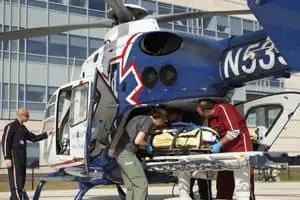
Medical Helicopter Accidents Cause Fatalities Among Patients. Last year was the deadliest in emergency medical helicopter history, with rule violations and dangerous actions on air-ambulance flights causing fatalities among patients and medical and flight crews, according to a recent USA Today report.
Now, the Wall Street Journal reports that industry groups have been at odds over how to reduce these risks and accidents.
A Textron Inc.’s Bell Helicopter-commissioned safety study—to be released Monday—is causing division in the industry, with Bell taking a step back, said the Journal. The study—prepared by Aerospace Risk Management Inc., a global consulting firm—is described by industry insiders as the most comprehensive of its kind, said the Journal.
The Journal notes that the report addresses patient and crew safety and looks at a broad range of topics including a variety of industry-wide issues that have long threatened safety. Aerospace Risk is known for its industry advisory work with airlines and helicopter operators.
Late last year, federal accident investigators announced that the air-ambulance industry and its regulators moved too slowly to stop the onslaughts of accidents that involved nine air-ambulance crashes and 35 deaths. According to a prior piece in the Washington Post, 29 deaths took place in the course of 13 emergency medical flights over one year, noting that the accidents, according to safety experts, were caused by human error or bad weather, to name a couple.
Pilots Broke Rules
Five of the crashes involved night flying in poor weather in which the pilots were unprepared, said the National Transportation Safety Board (NTSB), according to the USA Today report, which also noted that six deaths involved patients, representing the most deaths in a 12-month period for that industry.
The NTSB also learned that pilots broke rules or exercised risky behavior—such as a pilot agreeing to fly in inclement weather after another pilot refused to do so—in three of the cases.
The report was meant to promote accord and cooperation around “voluntary safety issues,” said the Journal, which were also meant to help stave “regulatory or legislative” actions. This is no longer the case. Expected to present some procedural challenges to companies who have long followed unchanging practices, the report has its critics, said the Journal.
Although some within the industry back the study and dozens of companies submitted information, members of the Air Medical Operators—a group representing firms that fly what are considered “some of the largest emergency medical fleets”—are reportedly critical, said the Journal.
Apparently, the report was to be released along with an announcement including those industry associations and helicopter safety groups willing to collaborate on solutions, said the Journal, but some operators “have threatened to withhold or cancel orders from Bell if the company released the report under its own name.” In response, Bell moved the report to safety advocacy group, the Flight Safety Foundation.
Kimberley Turner, chief executive of Aerospace Risk Management, said the reactions reflect the “relative immaturity” of industry and that “a mature industry with a well-established safety culture,” said the Journal “wouldn’t balk at having all the risks laid out on paper,” it quoted.
Need Legal Help Regarding Medical Helicopter?
The personal injury attorneys at Parker Waichman LLP offer free, no-obligation case evaluations. For more information, fill out our online contact form or call 1-800-YOURLAWYER (1-800-968-7529).
[sc name=”post-footers”]
Our Helicopter Accident attorneys are here to help you when you need it the most.